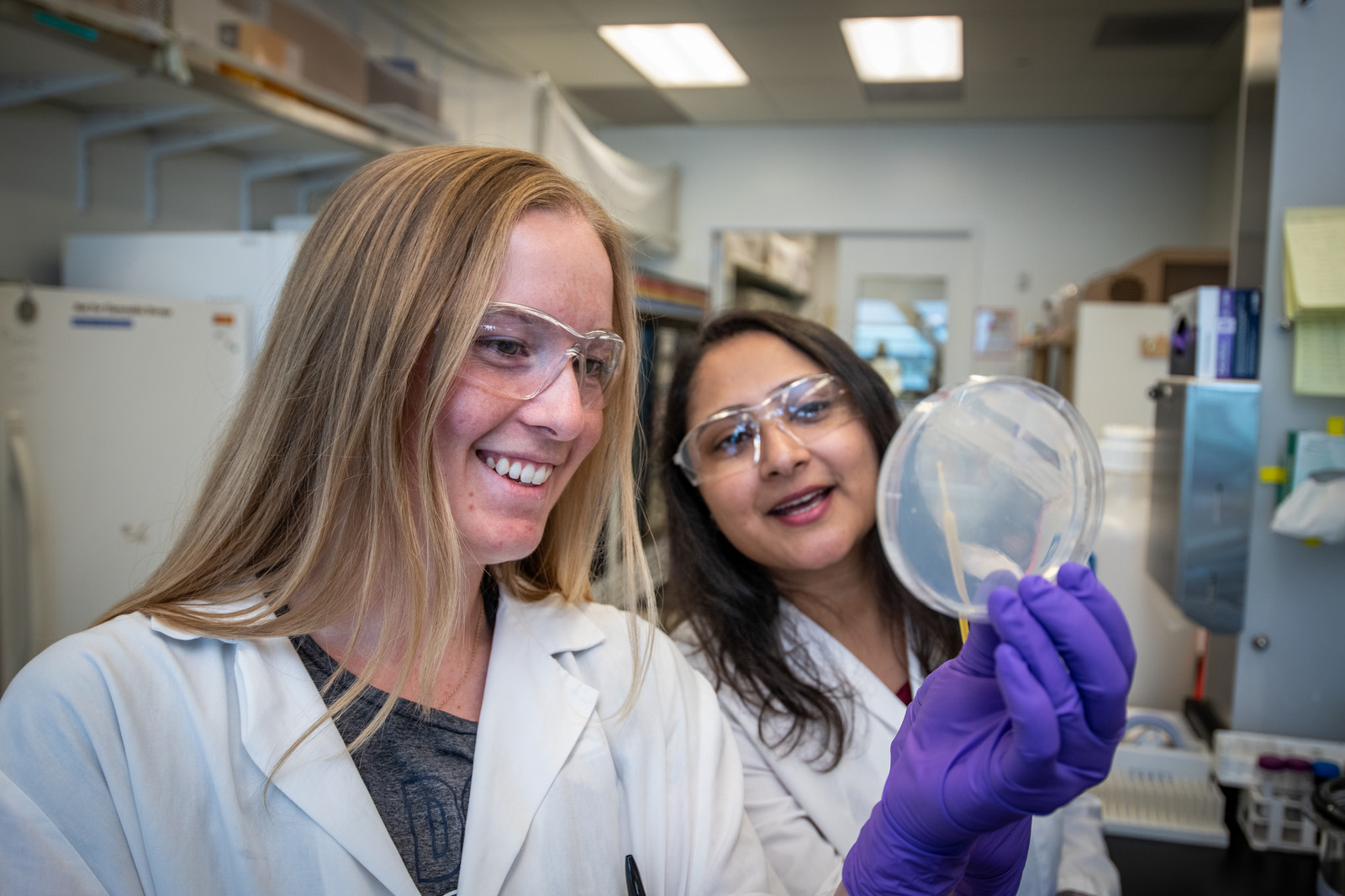In 2022, the Department of Energy’s Lawrence Berkeley National Laboratory (Berkeley Lab) delivered solutions for clean energy and a healthy planet, and made discoveries in fundamental science that expand what’s possible. Berkeley Lab staff also made significant progress on new capabilities that will deliver valuable research for the nation and world for decades to come.
Some of Berkeley Lab’s more popular science articles of 2022, which represent just a few of the Lab’s many achievements this year, are listed below (in no particular order).
But first, a few other important milestones: In March, the Lab hosted the National Energy Storage Summit, a virtual public event that connected thought leaders across industry, government, communities, and the research enterprise to catalyze partnerships and accelerate solutions around specific challenges to America’s energy storage future.
And in October, the number of Nobel Prizes received by Berkeley Lab scientists increased from 14 to 16. Former Berkeley Lab scientist John Clauser shared the 2022 Nobel Prize in Physics for experiments with entangled photons, establishing the violation of Bell inequalities and pioneering quantum information science. Clauser conducted this research in the early 1970s with the late Stuart Freedman. And Carolyn Bertozzi, a former Berkeley Lab scientist and Molecular Foundry director, shared the 2022 Nobel Prize in Chemistry for the development of click chemistry and bioorthogonal chemistry.
ESnet Launches Next-Generation Network to Enhance Collaborative Science

(Credit: Berkeley Lab)
In October, the Energy Sciences Network (ESnet) formally unveiled ESnet6, the newest generation of the high-performance network dedicated to science. For more than 35 years, ESnet – headquartered at Berkeley Lab – has served as the “data circulatory system” for the DOE, connecting all of its national laboratories, tens of thousands of DOE-funded researchers, and DOE’s premier scientific instruments and supercomputing centers. This interconnected system enables data to move quickly between sites and collaborators, accelerating time to discovery.
ESnet6 takes the network’s capabilities to the next level. With more than 46 Terabits per second of bandwidth, ESnet6 features a significant increase in bandwidth over prior generations of the network. With this boost in capacity, scientists can more quickly process, analyze, visualize, share, and store the mountains of research data produced by experiments, modeling, and simulations.
A Laser-Powered Upgrade to Cancer Treatment
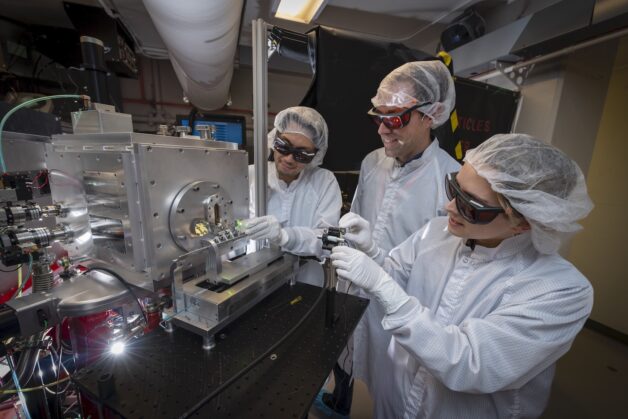
Kei Nakamura, Antoine Snijders and Lieselotte Obst-Huebl (from left) at the BELLA laser facility aligning cartridges containing human cells in the proton beam path. (Credit: Berkeley Lab)
A collaboration between Berkeley Lab biologists and physicists published their first paper on a new cancer treatment paradigm that harnesses laser-powered particle beams to eradicate tumors. The ultra-fast, high-energy burst of protons delivered by this type of particle accelerator shows exciting promise for effectively targeting and killing diseased tissue with minimal impact to the surrounding healthy tissue. Though more testing is needed before it can be used in human patients, the technique could improve the success rate of cancer radiotherapy while reducing side effects, and also lower the cost of radiotherapy facilities – meaning more people around the world would have access to life-saving treatment.
A Day in the Half-Life: More Microchips, Moore Problems

(Credit: Jenny Nuss/Berkeley Lab)
In the 6th episode of our podcast, A Day in the Half-Life, we explored the state of the industry that produces today’s state-of-the-art microchips – you know, those things that power all our devices!
We interviewed two scientists about the history of microchips (stretching back to the Apollo missions) and how the perpetual race to make them smaller and smaller has enabled the technologies we know and love. But now that individual transistors have shrunk to just a few atoms in width, engineers literally can’t go smaller. Our guests are part of a movement in the field to shift focus away from size and think instead about how to make chips smarter and more energy efficient by building them out of interesting and exotic materials.
Print, Recycle, Repeat: Scientists Demonstrate a Biodegradable Printed Circuit
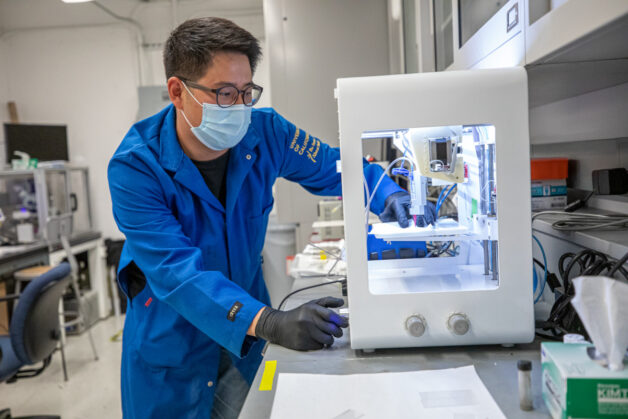
(Credit: Marilyn Sargent/Berkeley Lab)
According to the United Nations, less than a quarter of all U.S. electronic waste gets recycled. In 2021 alone, global e-waste surged at 57.4 million tons, and only 17.4% of that was recycled. But now, a team of researchers from Berkeley Lab and UC Berkeley have developed a potential solution: a fully recyclable and biodegradable printed circuit. The advance, which the researchers reported last May in the journal Advanced Materials, could divert wearable devices and other flexible electronics from landfill, and mitigate the health and environmental hazards posed by heavy metal waste.
“When it comes to plastic e-waste, it’s easy to say it’s impossible to solve and walk away,” said senior author Ting Xu, a faculty senior scientist in Berkeley Lab’s Materials Sciences Division, and professor of chemistry and materials science and engineering at UC Berkeley. “With this study, we’re showing that even though you can’t solve the whole problem yet, you can at least tackle the problem of recovering heavy metals without polluting the environment.”
The research was covered in ABC 7 (Bay Area).
Methane-Eating ‘Borgs’ Have Been Assimilating Earth’s Microbes

A digital illustration inspired by methane-eating archaea and the Borgs that assimilate them (Credit: Jenny Nuss/Berkeley Lab)
In Star Trek, the Borg are a ruthless, hive-minded collective that assimilate other beings with the intent of taking over the galaxy. Here on nonfictional planet Earth, Borgs are DNA packages that could help humans fight climate change.
Last year, a team led by Jill Banfield discovered DNA structures within a methane-consuming microbe called Methanoperedens that appear to supercharge the organism’s metabolic rate. They named the genetic elements “Borgs” because the DNA within them contains genes assimilated from many organisms. In a study published in Nature, the researchers describe the curious collection of genes within Borgs and begin to investigate the role these DNA packages play in environmental processes, such as carbon cycling.
Advanced Light Source Upgrade Approved to Start Construction

The upgrade to the Advanced Light Source at Berkeley Lab will add two new particle accelerator rings within the iconic building’s footprint. (Credit: Thor Swift/Berkeley Lab)
In November, the Advanced Light Source received federal approval to start construction on an upgrade that will boost the brightness of X-ray beams at the user facility at least a hundredfold. The milestone means Berkeley Lab’s biggest project in three decades has moved from the planning phase into purchasing, building, and installing the components. The upgrade will include building an entirely new storage ring and accumulator ring that together can produce brighter, more laser-like light. Scientists will use the improved ALS to study the electronic, magnetic, and chemical properties of materials and how reactions unfold at incredibly small scales. Insights from the research (which spans biology, chemistry, and physics) could have applications such as improved batteries, new materials for computing, and better medicines.
Basics2Breakthroughs: Hydrogen storage from material innovation to deployment

(Credit: Marilyn Sargent/Berkeley Lab)
Chemical engineer Peng Peng is helping develop a 100% renewable energy grid by investigating new materials for storing hydrogen gas, which can be used like a battery to stash power generated from solar and wind farms. Peng uses computer models to study how lab-scale material prototypes would perform at the industrial scale, and how much they would cost – accelerating the green hydrogen movement from discovery to deployment.
Giant Bacteria Found in Guadeloupe Mangroves Challenge Traditional Concepts
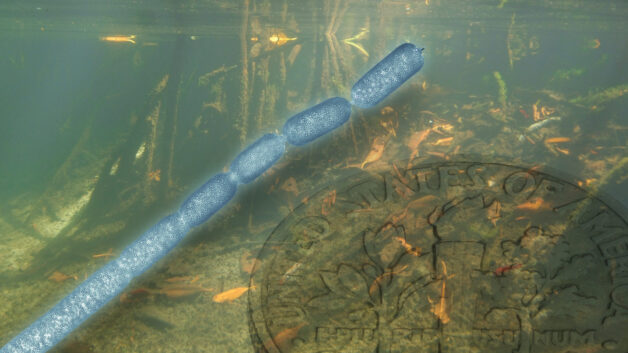
Artistic rendering of Ca. Thiomargarita magnifica with dime. (Credit: Mangrove photo by Pierre Yves Pascal; Illustration by Susan Brand/Berkeley Lab)
At first glance, the slightly murky waters in the tube look like a scoop of stormwater, complete with leaves, debris, and even lighter threads in the mix. But in the Petri dish, the thin vermicelli-like threads floating delicately above the leaf debris are revealed to be single bacterial cells, visible to the naked eye. The unusual size is notable because bacteria aren’t usually visible without the assistance of a microscope. “It’s 5,000 times bigger than most bacteria. To put it into context, it would be like a human encountering another human as tall as Mount Everest,” said Jean-Marie Volland, a scientist with appointments at DOE’s Joint Genome Institute (JGI).
This research was widely covered in the media, including in the New York Times, CNN, National Geographic, NPR, New York Times, Axios, and others.
Quantifying California’s Lithium Valley: Can It Power Our EV Revolution?
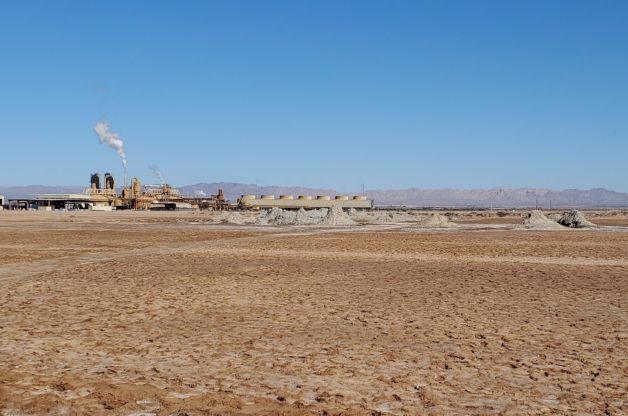
Mud volcanoes and mudpots next to the EnergySource Minerals power plant at the edge of the Salton Sea. (Credit: Michael McKibben/UC Riverside)
The Salton Sea geothermal field in California potentially holds enough lithium to meet all of America’s domestic battery needs, with even enough left over to export some of it. But how much of that lithium can be extracted in a sustainable and environmentally friendly way? And how long will the resource last? These are just a few of the questions that researchers hope to answer in a new project sponsored by the Department of Energy. Scientists from Berkeley Lab, UC Riverside, and Geologica Geothermal Group, Inc. will work together to both quantify and characterize the lithium in this hypersaline geothermal reservoir, located far beneath the surface of Earth near the Salton Sea in Imperial County.
The project was covered in top national and trade publications including the Wall Street Journal, CapRadio (NPR), PV Magazine, and CNN.
Dark Energy Spectroscopic Instrument (DESI) Creates Largest 3D Map of the Cosmos
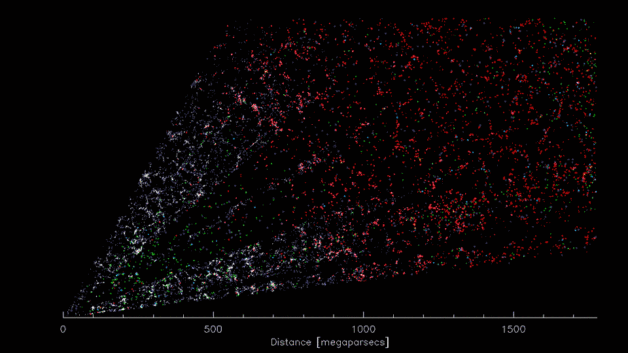
DESI’s three-dimensional “CT scan” of the Universe. (Credit: D. Schlegel/Berkeley Lab using data from DESI)
The Dark Energy Spectroscopic Instrument (DESI) capped off the first seven months of its survey run by smashing through all previous records for three-dimensional galaxy surveys, creating the largest and most detailed map of the universe ever. Yet it’s only about 10% of the way through its five-year mission. Once completed, that phenomenally detailed 3D map will yield a better understanding of dark energy, and thereby give physicists and astronomers a better understanding of the past – and future – of the universe. Meanwhile, the impressive technical performance and literally cosmic achievements of the survey thus far are helping scientists reveal the secrets of the most powerful sources of light in the universe. DESI is an international science collaboration managed by Berkeley Lab with primary funding for construction and operations from DOE’s Office of Science.
This achievement was covered in New Scientist, Wired, BBC, Science, and The Hill.
Using Microbes to Convert Greenhouse Gases to Valuable Chemicals

Deepika Awasthi, a scientist in Berkeley Lab’s Biosciences Area. (Credit: Thor Swift/Berkeley Lab)
What if there were a way to take greenhouse gases – gases such as carbon dioxide and methane which are warming our planet – and not only capture them but also then convert them into a useful product? Berkeley Lab scientist Deepika Awasthi has a project aiming to do just that. By bioengineering a microbe, she hopes to be able to capture both methane and carbon dioxide and produce a useful chemical that can be used in everyday products, such as automobile coatings and advanced textiles.
Bonus article from late 2021: New Smart-Roof Coating Enables Year-Round Energy Savings
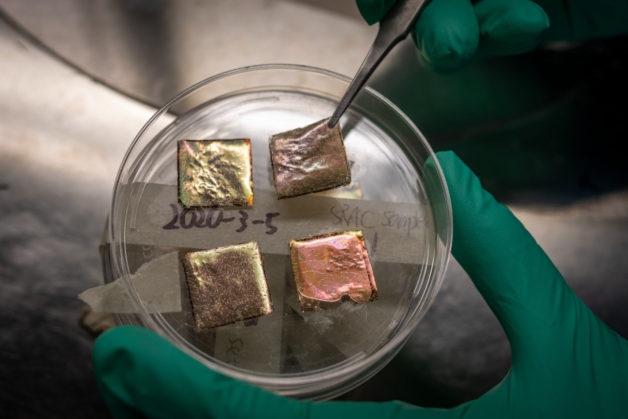
Samples of the temperature-adaptive radiative coating. The material looks like Scotch tape and can be affixed to a rooftop. (Credit: Thor Swift/Berkeley Lab)
Last December, Berkeley Lab scientists unveiled a surprising gift that keeps on giving: an all-season, smart-roof coating called TARC (temperature-adaptive radiative coating). TARC looks like Scotch tape, and can be affixed to a solid surface, such as a rooftop. Unlike cool-roof systems currently on the market, TARC automatically switches between different modes – from cooling in the summer, to heat retention in the winter – depending on outdoor air temperature. The work was reported in the journal Science.
“This is energy-free, emission-free air conditioning and heating, all in one device,” said Junqiao Wu, a faculty scientist in Berkeley Lab’s Materials Sciences Division and a UC Berkeley professor of materials science and engineering who led the study.
The research was covered in Popular Science and ABC-7 San Francisco.
Climate Change and Energy Research In the News
The Lab’s climate related research appeared in top newspapers and networks, including the New York Times, Washington Post, San Francisco Chronicle and CNN, raising our profile in solution-focused efforts to better understand and address the global climate crisis and extreme weather. Billion-dollar disasters, New York Times, A ‘megaflood’ in California could drop 100 inches of rain, scientists warn, Washington Post, Northern California heat wave may go down as worst in history, San Francisco Chronicle, Another monster hurricane season looms as we dawdle on climate change, Washington Post, Bigger ‘bomb cyclones’ could deluge Bay Area in coming decades, climate study finds, San Francisco Chronicle.
Our energy related research, which garnered the most press coverage this year, ranged from renewable energy, batteries and energy storage to grid resiliency and interconnection as well as air quality in buildings and schools, smart roofs and electrifying freight trains, strengthening our profile with industry, decisionmakers and the public. Are Solar Panels a Good Investment?, New York Times; U.S. Renewable Energy Will Surge Past Coal and Nuclear by Year’s End, Scientific American; Hurricanes Fiona and Ian gave solar power its time to shine, Politico; For some students, back to school will mean better-ventilated classrooms, NBC News; Battery-Powered Trains Are Picking Up Speed, WIRED; Biden admin lays out its vision for a battery industry, Politico.
# # #
Founded in 1931 on the belief that the biggest scientific challenges are best addressed by teams, Lawrence Berkeley National Laboratory and its scientists have been recognized with 16 Nobel Prizes. Today, Berkeley Lab researchers develop sustainable energy and environmental solutions, create useful new materials, advance the frontiers of computing, and probe the mysteries of life, matter, and the universe. Scientists from around the world rely on the Lab’s facilities for their own discovery science. Berkeley Lab is a multiprogram national laboratory, managed by the University of California for the U.S. Department of Energy’s Office of Science.
DOE’s Office of Science is the single largest supporter of basic research in the physical sciences in the United States, and is working to address some of the most pressing challenges of our time. For more information, please visit energy.gov/science.
